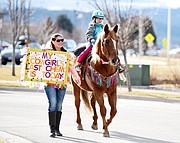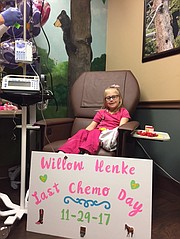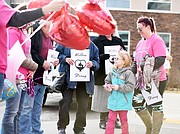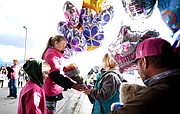Young cancer patient celebrates final chemo treatment
Wendy McCaffree shouted from a throng of 30-some people gathered outside Northwest Oncology and Hematology Wednesday afternoon. “Way to cowgirl up, Willow!”
Willow Henke, a 6-year-old brain cancer patient, rounded the corner and gave a shy wave to her supporters. This wasn’t any ordinary trip to the hospital — it was Henke’s last chemotherapy treatment and she arrived in style — on the back of her barrel-racing horse, Wrangler.
Walking beside the duo was Henke’s mother Emily, who wiped away tears as she wielded a sign that read “My cowgirl’s last chemo is today.”
Family, friends, teachers and medical staff who’d been there for Willow’s 18-month-long battle greeted the rider with resounding applause and cheers. Leading the charge was a convoy of law enforcement vehicles — among them, a fire truck, Humvee, and not one, but six Montana Highway Patrol cars.
For a journey that began on horseback, it was only fitting that it should end there.
It was a moment of celebration and long-awaited relief.
Willow’s tumor was shrinking.
Her Wednesdays wouldn’t be spent in the hospital any longer.
And at last, she could finally be a kid again.
After more than a year of chemotherapy, at 3:04 p.m. on Nov. 29, Willow completed her 46th and final infusion.
“In the clinic world we see a lot of hard things … so it’s really awarding to see them make it through all their therapy,” said Willow’s doctor, Dr. Carrie Neuhardt. “Willow is probably one of the kindest most sensitive children that we have taken care of — she was always looking out for others.”
“She’s a grownup in a little girl’s body,” Becky Henke said, as she watched Willow greet friends and family before her appointment. “She’s gone through stuff that I can’t imagine and she’s just been awesome through it all. She’s pretty excited about all of this being all done.”
And so is her family.
Emily Henke knew something wasn’t right when Willow was riding Wrangler last February. She rode over to her mother and complained of a pain inside her head when she trotted. Ten minutes later, the pain brought Willow to tears.
The next day, things got worse.
Emily and Willow were walking across a grocery store parking lot, when the 6-year-old collapsed, grabbing her head, screaming and crying.
“I thought wow, something’s not right here,” Emily recalled.
She took Willow to see a nurse practitioner who said her symptoms indicated a concussion and advised the Henke’s to limit Willow’s stimulation — no TV, no bikes, no bright lights.
But Willow’s pain kept getting worse.
“She was consuming a bottle of baby Tylenol every two days to try to control this head pain. As a mom, I knew something was wrong,” Henke said.
She took her daughter back in for medical attention for a second, third, fourth and fifth time, but still the recommendations were the same: reduce her stimuli.
“I asked every single time for an MRI and they all told me it’s not necessary,” Henke said.
After the fifth appointment, Henke returned to her car and sobbed.
Something was clearly wrong, but she was no closer to finding a solution.
Someone had mentioned that a chiropractor may help manage her head pain, so Henke pulled out her phone and located a provider in Whitefish who specialized in cranial work.
An hour later, the chiropractor placed her hands on Willow’s head to examine her skull.
“She turns to me and she goes ‘you need an MRI,’” Henke said.
Her mother’s intuition was right.
That night, the family drove to Seattle Children’s Hospital and soon met with a neurologist who confirmed that something more than a concussion was at play.
“I don’t know why the words came out of my mouth, but I said, ‘Could it be a brain tumor?’” Henke said.
The neurologist ordered an MRI to find out more and the family returned to Montana.
At 3:20 p.m., April 21, Willow underwent her first MRI and doctors told Emily that no news was good news and she likely wouldn’t hear anything about the results for 24-48 hours.
That evening, Emily had just sat down to dinner with her family when the phone rang.
It was Seattle.
They found “something” in the MRI.
Willow would need an emergency MRI the following day.
And that was it. Click.
“I just remember dropping the phone on the counter. I remember walking outside and crying and Willow’s on my heels like, ‘who was that Mommy?’ I just knew, I knew it was bad,” she said.
At 4:47 p.m., the next day, the phone rang again.
“That day, I can just see it,” Emily said, her voice wavering. “I was in the kitchen and my kids were outside in the garden playing on their stick horses and I answered the phone. It was the neurologist from Seattle and she said ‘Emily, it’s a brain tumor.’”
She scrambled for a pen, but her hand was shaking so badly she couldn’t write down what the doctor was saying.
She needed a moment to come back to Earth. And when she got there, another blow was waiting.
“It’s right behind her right eye, she said. Emily, she’s going to go blind,” Henke recalled.
And that’s when she lost it.
But Emily transitioned from grieving for her daughter to action.
They returned to Seattle where doctors eventually told her the tumor was inoperable due to its proximity to the carotid artery and the best course of action would be to do nothing while the tumor was stable.
The tumor itself was shaped like a snake and wound around Willow’s optic nerve — the channel that passes imagery from the eye to the brain.
In the meantime, Willow was declared legally blind in her right eye — likely a gradual transition due to the slow growing nature of the cancer.
The family managed her pain with a $987 bottle of strong anti-inflammatories and made sure Willow got regular MRIs.
For a while, things were stable.
Until they weren’t.
In October 2016, a vision test revealed that her sight in the right eye had declined from 20/400 to 20/800 and doctors recommended they proceed with chemotherapy.
Willow and Emily spent those next seven weeks in Seattle at the Ronald McDonald House while Willow received chemo infusions each Wednesday — appointments that could range from six to eight hours. They continued treatment at Northwest Oncology and Hematology under the care of Dr. Carrie Neuhardt.
“In the beginning it was good, she tolerated it well, but the deeper we got into it, the worse and worse it got,” Emily said. “We got to point where she would be vomiting 10 to 15 times while she was being infused — and that’s with anti-nausea medication.”
At one point, Willow was 0.6 kilograms away from requiring a feeding tube, but soon after she dropped to her lowest weight, she rebounded, gaining half a pound, Emily said.
But not every struggle presented a victory — Willow also lost half her hair and was sick five days per week.
Even something as simple as the smell of hand sanitizer would cause her to vomit.
But her family was with her every step of the way.
One October day, Willow was perched on a stool in front of the toilet, sick from chemo.
Emily watched as her 3-year-old son Trekk peeked in before returning moments later with a stool of his own so he could sit beside her and rest a reassuring hand on her leg.
“I tell everybody that you find strength within the journey that you didn’t know you had,” Emily said. “There’s time when I’d get really upset and really angry that this is happening to my child. But there’s also times when I feel like, if there was a child in the world that had to have this, God or whoever the higher power is, picked her because she’s so strong.”
In addition to her family, barrel racing also provided a source of strength for Willow throughout her battle with brain cancer.
“It’s burned into my memory: She’s leaning over the toilet, throwing up and she has a fever and says, ‘I can still rodeo this weekend right mom?’” Emily recalled.
Wendy McCaffree, a friend in the barrel racing world, echoed her sentiments.
“All she wanted to do when she got back from Seattle was get back on her horse,” McCaffree said. “They say horses are therapy and as Winston Churchill said, ‘What’s good for the inside of a man is the outside of a horse,’ and it rings true.”
Willow continued to ride the local rodeo circuit when she could, and won a few belt buckles in the process.
But Willow was clear that she didn’t expect handouts in the arena just because she had cancer.
“She won a belt buckle this spring at our year-end O-Mok-See banquet and she said, ‘Now wait a minute, did I win this belt buckle because I rode well or because I have brain cancer?’” Emily said. “She wants to earn it and she knows that she can. I really feel that that’s what gave her the strength to push through.”
This winter, Willow will attend school for the first time and meet the classroom peers she’s only seen up until now via Skype.
She’s looking forward to recess and, of course, riding her horse.
An October MRI revealed that Willow’s tumor shrunk by 4 mm in length and 3 mm around, prompting the end of her chemotherapy.
“They say that there’s a 50 percent chance that she’ll have to repeat chemo at some point, but we’ll cross that bridge when we come to it,” Emily said. “I just think after everything — 46 infusions, 11 ER visits, one ambulance ride — everything she’s had to go through, we needed to end it with a boom.”
Reporter Mackenzie Reiss may be reached at 758-4433 or mreiss@dailyinterlake.com.












